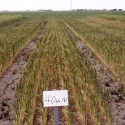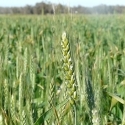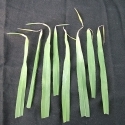10 Feb 2015
Soil sampling for 2016
Good sampling is the first step in 4R nutrient stewardship
 Soil sampling at Dahlen Long Term Site
Soil sampling at Dahlen Long Term Site
Soil testing is the first step in identifying the RIGHT nutrient/s required, the RIGHT place for them and assists with determining the RIGHT rate to apply.
The greatest potential for error in soil testing is in taking the soil sample. A 0.5 kg sample collected and sent to the laboratory may represent 100 ha or more, so collection of a truly representative sample is a critical step. In the laboratory itself. as little as 0.5 g of soil may be analysed as representing a paddock. If a good sample is collected, the results of the test can provide a reliable estimate of the nutrient status of the soil. In larger fields, increasing the number of samples helps improve the reliability of the recommendations. The same sampling procedures should be used, regardless of the size of the field being sampled.
Carefully collect the soil sample to be sure that test results will be representative. Soil testing laboratories often provide sampling instructions that may include these steps:
For Field Sampling - for fertility assessments and fertilizer planning.
- Sample at about the same time each year as values do change with season.
- While sampling each year is ideal, it is probably only necessary to sample paddocks each 2-3 years as soil test values for immobile nutrients do not change very quickly.
- A separate soil sample should be taken from fields that have distinct topography, soil types or colors, or past management practices. Thus, a large field may be divided into uniform soil areas or past cropping areas depending on the specific site. Assign a permanent identification number. Record the field numbers. Keep a map of sample areas.
- The sampling plan may be at a whole field where management zones are not used, grid sampling where zones are being developed, or by management zone if these are to be treated differently (See diagram).
- Use a clean plastic bucket, especially for micronutrient tests. (Metal buckets can contaminate the sample.)
- Sample to the correct depth - 10 cm is the most common depth for samples (P, K, S, micros) and 0-60 cm for deep samples (N, S). Depth is critical as immobile nutrients (like P, K and micros) are largely in the top layers. Deeper sampling gives relatively low values, and shallow sampling gives relatively higher values.A shovel is the worst possible collection tool as depth is not controlled.
- Subsoil samples (>10 cm) can be used to evaluate properties that may limit root deoth - such as pH (v.high or v. low), sodicity, salinity, boron.
- Collect more than 20 cores or sub-samples at random over the sampling area or paddock to give a composite sample for that area. Depending on the sampling tool used (soil probe, tread sampler, auto-corer), the composite sample may weigh one to several kg.
- Thoroughly mix the cores from a sample area to obtain a representative sample for analysis. This step is extremely important. Clods should be broken with the fingers while mixing is being done. Improper mixing can result in large sampling errors.
- Several types of containers may be used for sending the sample to the laboratory. Some laboratories provide these. New and clean, heavy duty bags are usually supplied and can be bar-coded to ensure identity when received at the laboratory.
- Fill out the information sheet completely, keep a copy of the results and dispatch as soon as possible.
- Use ASPAC/Fertcare accredited laboratories as they use methods test and accepted in Australia. The link at left will allow you to see if the laboratory participates in ASPAC proficiency standards.
For Problem Areas (diagnostic sampling)
- Collect separate samples using the techniques described above, from good and poor areas.
- Take both surface and subsoil samples.
- Include description of problem and send the description with samples.
Sampling for wide rows and banded fertilizers
Because some elements, such as soil P, are relatively immobile, where banding is practiced such as with precision placement of fertilizer, soil sampling requires special consideration. In such cases, random sampling would give a high test result if only a few bands were included in the sample. Where the locations of the bands or drill rows are known, research conducted in the US has suggested that a ratio of 1:20, 1:16 and 1:8 in-the-band cores to between-the-band cores should be considered for 76 cm, 61 cm, or 30 cm band spacing’s, respectively. An alternative is to take a slice of soil across the rows to include banded and non-banded soil. The reliability of this method, however, has not been evaluated for predicting fertilizer responses relative to other sampling methods.
More about: Best Management Practices




